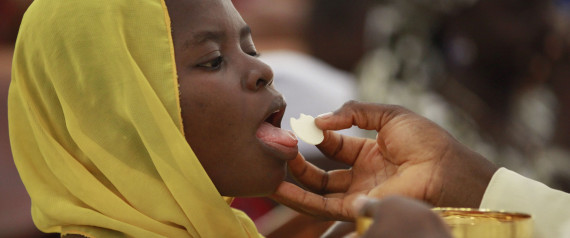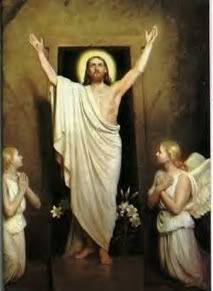St. Paul is adamant about the importance of Jesus' Resurrection to the Christian faith. He tells us: "If Christ has not been raised, your faith is futile and you are still in your sins. Then those also who have fallen asleep in Christ have perished" (1 Cor. 15:17-18).
Fortunately for us, there is a huge amount of evidence that Jesus' Resurrection really happened--that it is a true miracle, one that we can believe in. We can only cover a fraction of that evidence in this email, but here are seven key points:
1. The Empty Tomb
The starting point for proving Jesus' Resurrection is the fact that his tomb was empty. When the disciples visited it (e.g., Luke 24:12, John 20:3-9), they found it empty. This calls for an explanation.
The explanation that they offered was that he had been raised from the dead. Before we look at why they said that, let's look at a couple of additional points that confirm that the tomb really was empty.
2. Opponents Agree
The Jewish authorities agreed that Jesus' tomb was empty. If they had not also found the tomb empty then they would have simply pointed to the presence of Jesus' body as evidence that he had not been raised from the dead.
They, too, needed an explanation for this fact--only one that did not imply the Resurrection. Matthew records that many first century non-Christian Jews claimed that the disciples stole the body (Matt. 28:11-15).
This is implausible because the Jewish authorities themselves had gone to the Roman governor, Pilate, and arranged to have a guard set over the tomb to prevent precisely this (Matt. 27:62-66). Such guards would have faced severe consequences had they fallen asleep and let anyone violate what they were guarding. This is why the authorities had to give them money and promise to protect them for telling this story (Matt. 28:12, 14).
3. Women Were the First Witnesses
All four gospels record that women were the first people to find the tomb empty (Matt. 28:5-8, Mark 16:2-8, Luke 24:1-8, John 20:1-18). This is significant because, due to the prejudices of the day, women were often regarded as unreliable witnesses.
Consequently, if you were making up a story that you wanted people to believe, you would not make women the first witnesses to the key fact. The fact that the gospels record that women were the first witnesses to the empty tomb (and, in Mary Magdalen's case, as the first witness to the risen Christ) is therefore a mark of truth.
4. Post-Resurrection Appearances
And it wasn't just his immediate disciples. According to St. Paul more than 500 individuals witnessed him alive after his Resurrection, many of whom were still alive to be questioned about the fact (1 Cor. 15:6).
So far we have looked at evidence that Jesus' tomb was empty. Now we turn to why his disciples said he had been raised from the dead. Simply put: They saw him alive and interacted with him after his death (Matt. 28, Mark 16, Luke 24, John 20-21).
5. Jesus' Broken Heart
One could claim that Jesus was able to appear alive after the Crucifixion if he didn't really die on the Cross. Perhaps he just appeared to die or, as some have put it, he "swooned" on the Cross. This is impossible because of a fact John records: When Jesus died, a Roman centurion pierced his side with a lance and blood and water flowed out (John 19:34).
In the ancient world, they wouldn't have known the medical explanations for this phenomenon we well as we do, but to produce this kind of effect both extreme prior trauma and a deep body cavity puncture wound by the spear (likely piercing the pericardium--the sac that surrounds the heart) are required. Nobody could have survived that, particularly not in the ancient world and without even primitive medical care administered. (He was hurriedly buried, remember?)
6. Twin? . . . What Twin?
One also could claim that Jesus didn't really die on the Cross--or, if he did, that it wasn't really him who appeared alive afterwards--if someone else looked just like him, enough to fool his own disciples. In other words, if he had a twin.
But only about 1 in 300 people have an identical twin in the first place. It's a rare phenomenon.
And if Jesus did have an identical twin, people would have known about it. Certainly, his family would have, and his close associates would have known as well.
Think about it: If you knew someone who had an identical twin and you seemed to see him after his death, what would you think? That he had risen from the dead or that you were seeing his twin? Or perhaps that it was his twin who died. Either way, you would think that there was a perfectly natural explanation other than Resurrection.
7. You Don't Die for a Lie
If it was really Jesus who died on the Cross, and if he had no twin, and if his disciples reported him alive afterwards then this could have been false if they were lying.
Were they?
The evidence says otherwise.
While we don't have as much information as we would like, we do have information about where Jesus' core disciples (the apostles) went to preach after his ministry. There they faced significant persecution, as well as martyrdom for the faith.
They were already dying for their faith when the New Testament was being written, as the cases of St. James son of Zebedee (Acts 12:1-2) and St. Peter show (John 21:18-19).
What we don't have is an instance of any of Jesus' disciples saying, "Hey, I wasn't serious. Jesus didn't die and rise again. It was all a hoax or a mistake or a spiritual allegory of some kind. You can let me go now."
Nowhere, anywhere that the Christian message went, do we find that.
The apostles were willing to die for their faith, and as it has often been quipped, "You don't die for a lie."
We are truly fortunate that, by God's providence, we have evidence for the Resurrection of Christ that, even 2,000 years later, is substantial enough to stand up under cross-examination.
There have been all kinds of alternative theories proposed, but a reasoned look at the evidence reveals the problems with each one.
The case for the Resurrection is solid. And so is the basis of our faith.



No comments:
Post a Comment